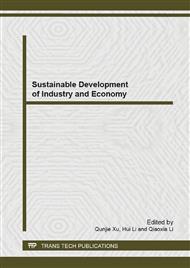[1]
S. Dinda. Environmental Kuznets curve hypothesis: a survey. Ecological Economics, 49(4)(2004), pp.431-455.
DOI: 10.1016/j.ecolecon.2004.02.011
Google Scholar
[2]
M. Mazzantia, A. Montinib, R. Zobolic. Municipal waste generation and the EKC hypothesis new evidence exploiting province-based panel data, Applied Economics Letters, Vol. 16(7) (2009), pp.719-725.
DOI: 10.1080/13504850701221824
Google Scholar
[3]
M. E. Kahn. A household level environmental Kuznets curve. Economics Letters, Vol. 59(2)(1998), pp.269-273.
DOI: 10.1016/s0165-1765(98)00035-4
Google Scholar
[4]
B. Girod and P. Haan. More or better? A model for changes in household greenhouse gas emissions due to higher income. Journal of Industrial Ecology, Vol. 14(1)(2010), pp.31-49.
DOI: 10.1111/j.1530-9290.2009.00202.x
Google Scholar
[5]
G. Baiocchi, J. Minx and K. Hubacek. The Impact of Social Factors and Consumer Behavior on Carbon Dioxide Emissions in the United Kingdom:A Regression Based on Input-Output and Geodemographic Consumer Segmentation Data. Journal of Industrial Ecology, Vol. 14(1)(2010).
DOI: 10.1111/j.1530-9290.2009.00216.x
Google Scholar
[6]
I. Martı́nez-Zarzoso and A. Bengochea-Morancho. Pooled mean group estimation of an environmental Kuznets curve for CO2. Economics Letters, Vol. 82(1)(2004), pp.121-126.
DOI: 10.1016/j.econlet.2003.07.008
Google Scholar
[7]
J. Andreoni and A. Levinson. The simple analytics of the environmental Kuznets curve. Journal of Public Economics, Vol. 80(2)(2001), pp.269-286.
DOI: 10.1016/s0047-2727(00)00110-9
Google Scholar
[8]
E. M. Kahn. A household level environmental Kuznets curve. Economics Letters, Vol. 59(2)(1998), pp.269-273.
DOI: 10.1016/s0165-1765(98)00035-4
Google Scholar
[9]
E. M. Kahn and J. Schwartz. Do richer people pollute more or less? New evidence on household level vehicle emissions Kuznets curves, Working paper (2004). http: /papers. ssrn. com/sol3/cf_dev/AbsByAuth. cfm?per_id=16082.
DOI: 10.2139/ssrn.564627
Google Scholar
[10]
A. Cox, A. Collins, L. Woods and N. Ferguson. A household level environmental Kuznets curve? Some recent evidence on transport emissions and income. Economics Letters, Vol. 115(2)(2012), p.187–189.
DOI: 10.1016/j.econlet.2011.12.014
Google Scholar
[11]
V. Esteve, and C. Tamarit. Threshold cointegration and nonlinear adjustment between CO2 and income: The Environmental Kuznets Curve in Spain. Energy Economics, Vol. 34(6)(2012), p.2148–2156.
DOI: 10.1016/j.eneco.2012.03.001
Google Scholar
[12]
Z. Feng, L. Zhou and Y. Wei. The impact of residents' lifestyle on CO2 emissions in China. Energy of China(In Chinese), Vol. 32(3)(2010), pp.37-41.
Google Scholar


